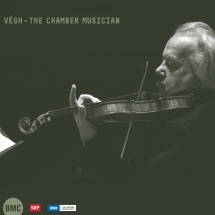Product Details
- An MVD Exclusive
- SKU: BMCCD262
- Format: CD
- UPC: 5998309302626
- Street Date: 08/10/18
- PreBook Date: 07/06/18
- Label: BMC Records »
- Genre: Classical
- Run Time: 140:41 mins
- Number of Discs: 2
- Year of Production: 2018
- Box Lot: 25
- Territory: NA,GB,AU
- Language: English
Product Assets
Sandor Vegh - Vegh: The Chamber Musician
The 4th double disc of BMC's exclusive Vegh series contains previously unreleased recordings by Sandor Vegh

- List Price: $19.99
- Your Price: $19.99
- In Stock: 40
You must login to place orders.
Violinist, chamber musician, conductor and teacher, Sándor Végh was one of the most important musicians of the twentieth century. He left Hungary in 1946, to live in France, then later Switzerland and Germany, and in the final decades of his life he made his home in Salzburg in Austria. Végh played with the finest musicians of the century. He performed as a chamber partner to Ernő Dohnányi, Annie Fischer, Mieczysław Horszowski, Wilhelm Kempff, Rudolf Serkin and Yehudi Menuhin. For many years he played with Pablo Casals at the legendary cellist's Prades Festival. His legendary Végh Quartet played together for nigh on forty years, all the while being at the cutting edge of the music world. Right from his early student years, Sándor Végh showed great interest in contemporary music, and this attraction, curiosity, and commitment lasted all through his life. In the selection of the pieces an important aim was that the choice should reflect the simultaneous presence of traditions and modernity in Vegh's art. With this in mind, this 4th double disc of BMC's exclusive Vegh series features the Beethoven C major 'Razumovsky' Quartet, with which the Vegh Quartet won the Geneva Music Competition, the great Viennese composer's Violin Sonata No. 10 in G major and Schubert's String Quintet in C major, along with Arnold Schoenberg's Pierrot lunaire, a defining piece of the 20th century, performed by members of the Vegh Quartet and selected musicians.
Track Listing
Disc 1:
|
Press Quotes
Budapest Music Center Records (BMC) has recently released a number of double-CDs devoted to the art of Sándor Végh in his roles as concerto soloist, chamber recitalist, quartet leader and ensemble partner. These valuable historical documents are largely, but not exclusively, the products of German radio broadcasts of the 1950s and come with identical booklet notes. The release under review captures him as primarius of his quartet and as a sonata player. In the latter role he and Swiss pianist Paul Baumgartner are heard in a 1957 performance of Beethoven's Op.96 sonata. This is very much a meeting of musical equals, Végh being too subtle a musician to want to subvert the proprieties of duo performance - some of his violinistic colleagues had fewer scruples - and so the result is a consonant one. Phrasing is detailed in a relaxed approach to the first movement with a fully expressive but not over-vibrated Adagio. The finale is not over-scaled, the performance remaining a truly sympathetic one. If one misses, from time to time, the depth of the live wartime Szigeti-Arrau collaboration or the same violinist's post-war live reading with Schnabel, Végh's approach is still enriching, if not necessarily exalted. His quartet plays Beethoven's Rasumovsky Quartet No.3 in January 1954 in a SRF broadcast. A couple of years earlier the group had recorded the cycle of quartets for the Haydn Society, an undertaking that was very well transferred by Music & Arts CD1084 in a 7-CD box. The approach in the broadcasting studio is, perhaps inevitably, consistent with their cycle. The reading is direct, unsentimental and somewhat objectified. With clarity and few expressive gestures that obtrude, rhythmic detail is precise, pizzicati are well balanced, and tempi don't linger. Their colleagues in the Hungarian Quartet also recorded a cycle around this time and they prove to be the more communicative interpreters; as the years went by a greater sense of musical breadth entered into the Végh's performances but this reading represents them as fine exponents of the repertoire. Earlier, in July 1948, they were joined by cellist Éva Czakó (1926-78) for a reading of Schubert's Quintet in C major. She was the wife of the group's violist György Janzer and both were members of Arthur Grumiaux's string trio with whom they made a number of recordings, including a wonderful set of Beethoven's string trios. Comparing the Végh in 1948 and in their famed collaboration with Pablo Casals in Prades in 1961 is to do no more than to note the extraordinary encouragement of expressive intensity and breadth brought to bear by the cellist. Predictably each movement is much tighter in this radio broadcast, which is around four minutes brisker than the Prades reading. To those unsympathetic to Casals' heavenly length the earlier reading, cooler, more classical, but hardly devoid of feeling, will be welcome. This, like the Beethoven quartet, was taped for Swiss Radio (SRF) whilst the remainder of the programme comes from Cologne radio. The final work is Schoenberg's Pierrot lunaire, where the quartet was joined by vocalist Jeanne Héricard and a raft of fine instrumentalists anchored by the great Italian pianist Pietro Scarpini, a most impressive exponent of Schoenberg's Concerto and other works. You can hear another broadcast performance of his Pierrot lunaire in a RAI traversal in 1960 on Rhine RH-010 (see review) where the vocalist is Magda Laszlo. In Cologne, the range of moods and expressions are readily brought out and the quartet's sense of colour equally in a well-balanced studio recording from November 1957. This is a notably well-selected pair of discs that reveals different facets of the violinist's art from the late 1940s onwards.
—Jonathan Woolf, musicweb-international.com
